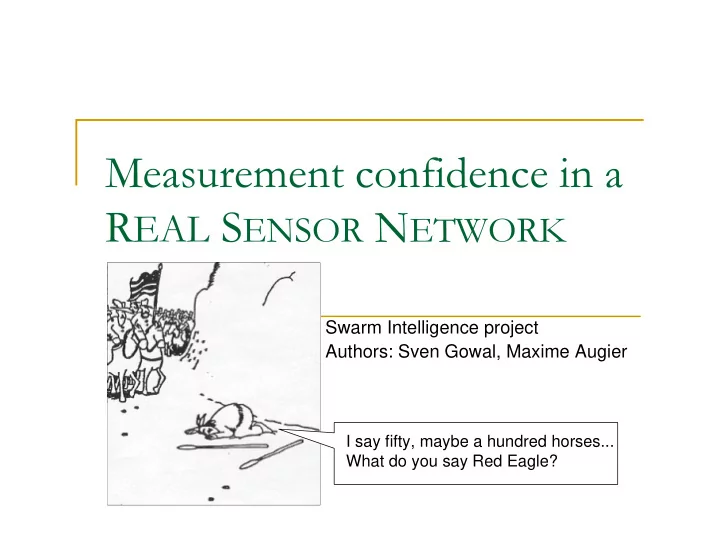

Measurement confidence in a R EAL S ENSOR N ETWORK Swarm Intelligence project Authors: Sven Gowal, Maxime Augier I say fifty, maybe a hundred horses... What do you say Red Eagle?
Abstract � Familiarize one self with TinyOS/nesC � Implement some approach to filter raw light measurements � Demonstrate the importance of collaboration
Background � TinyOS � OS designed for wireless embedded sensor networks. � nesC � Extension to the C programming language designed to embody the structuring concepts and execution model of TinyOS. � TinyDB � query processing system for extracting information from a network of TinyOS sensors.
Miscroscopic abstraction level � Although not required � Easier and faster algorithms implementation � Easier testing � MoteSim � Our simulator � Adapted to our task
MoteSim � Takes as input a network configuration file � Outputs the filtered light as well as the raw light sensed by each mote (node). � Able to plot
Realistic abstraction level � Once we decided on the algorithm according to the results given by MoteSim. � Used TinyDB to help us get the results from the MicaZ motes. � Add an attribute (f_light) � Able to query with « SELECT f_light FROM sensors » � Code still totally independent
Algorithm used (outline) � Weighted average of the raw light measurements by a mote and its neighbors � Average given as input to a low pass filter (leaky-integrator)
Algorithm used (average) � Averaging formula: Raw light perceived by the neighbor n at time i Personal contribution coefficient ( k ∊ [0,1]) Averaging over space Number of neighbors the mote has Raw light perceived at time i by the mote
Algorithm used (average) � Averaging already produces some kind of filtering: � 10 motes (9 neighbors). � Raw light measured is N(10, 0.5) . � k = 0.1. � Mean error reduced from 0.5 to 0.17 � 300% improvement � Hint: Collaboration is important.
Algorithm used (average)
Algorithm used (filtering) � Using only an average is not sufficient if the number of neighbors is limited. � Low pass filtering via a leaky-integrator (for simplicity). Leaky-integrator coefficient ( l ∊ [0,1]) � Leaky-integrator formula: Averaging over time Data received by the filter at time i Filtered data at time i
Algorithm used (filtering) � Filtering is very efficient even with a lower number of neighbors: � 1 mote (0 neighbors). � Raw light measured is N(10, 0.5) . � l = 0.3. � Mean error reduced from 0.5 to 0.19 � 267% improvement � Hint: Filtering is important.
Algorithm used (filtering)
Results � Algorithm (average + filtering) was run on a real 8 motes network � Number of neighbors between 0 and 3. � High sampling rate to see how noise interfered. � Whole day � Radio strength reduced to the strict minimum (approx. 3 meters radius).
Results Global pattern preserved even if the motes were in different light environment Noise (transmission errors mostly) Night Day
Discussion (introduction of a metric) � Useful to measure the performance � The metric has to take into account 2 aspects � Collaboration Different motes should follow the same pattern. � � Personal data A mote should follow the pattern dicted by the light it � measures and not only rely on its neighbors. � Let’s use the statistical correlation
Discussion (metric) Collaborative coefficient Raw light � Performance of a single mote: � Performance of the whole network: Filtered light
Discussion (metric) � The metric yields a real number between 0 and 1. � 1 is the better performance one can obtain. � Let’s find a reference value on which we can base our observations. � Will use a = 0.8
Discussion (comparison) � Used MoteSim to compare 3 basic algorithms � Nop : outputs as the filtered light the raw intensity of the light (no averaging, no filtering). � Weighted Mean : performs a weighted mean over the raw intensities perceived by its neighbors and a small historic of the raw values perceived by the mote itself (averaging, little filtering). � Weight & Filter : performs a weighted average like Weighted Mean but in addition it uses a low pass filter (averaging, filtering).
Discussion (comparison) � Simulated a network of 8 motes � Different neighborhood size (0, 2-3, 7) � Raw light is a N( μ ,0.5) , μ is a U(9, 11) . � 1000 steps.
Discussion (comparison) Outperforms the other algorithms Filtering happens for bigger neighborhood Performance size. Reference value Neighborhood size
Discussion (comparison) � Performance obtained for the real networks is unexpectedly very good: 0.9797 � Very close to 1, probably due to: � Not as much noise. � Maybe just lucky.
Conclusion � Filtering occurs with very simple algorithms such as a simple average as long there are enough neighbors. � For unstable/small neighborhood, filtering must be used in order to yield better results.
� Thanks � Any questions?
Discussion (metric - recall) � Correlation � With � Covariance � Standard deviation
Recommend
More recommend